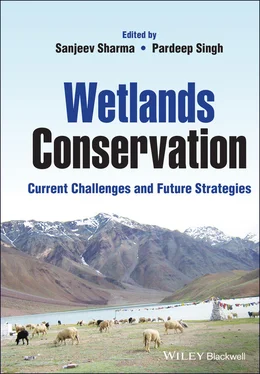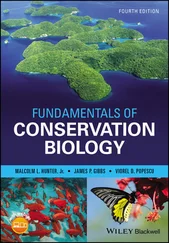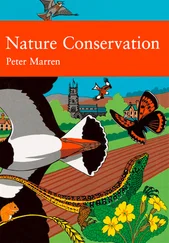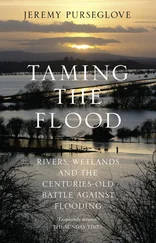Wetlands Conservation
Здесь есть возможность читать онлайн «Wetlands Conservation» — ознакомительный отрывок электронной книги совершенно бесплатно, а после прочтения отрывка купить полную версию. В некоторых случаях можно слушать аудио, скачать через торрент в формате fb2 и присутствует краткое содержание. Жанр: unrecognised, на английском языке. Описание произведения, (предисловие) а так же отзывы посетителей доступны на портале библиотеки ЛибКат.
- Название:Wetlands Conservation
- Автор:
- Жанр:
- Год:неизвестен
- ISBN:нет данных
- Рейтинг книги:3 / 5. Голосов: 1
-
Избранное:Добавить в избранное
- Отзывы:
-
Ваша оценка:
- 60
- 1
- 2
- 3
- 4
- 5
Wetlands Conservation: краткое содержание, описание и аннотация
Предлагаем к чтению аннотацию, описание, краткое содержание или предисловие (зависит от того, что написал сам автор книги «Wetlands Conservation»). Если вы не нашли необходимую информацию о книге — напишите в комментариях, мы постараемся отыскать её.
An up-to-date overview of approaches for addressing wetlands degradation and its effects on ecosystem services, human health, and other ecosystems Wetlands Conservation: Current Challenges and Future Strategies
Wetlands Conservation: Current Challenges and Future Strategies
Wetlands Conservation — читать онлайн ознакомительный отрывок
Ниже представлен текст книги, разбитый по страницам. Система сохранения места последней прочитанной страницы, позволяет с удобством читать онлайн бесплатно книгу «Wetlands Conservation», без необходимости каждый раз заново искать на чём Вы остановились. Поставьте закладку, и сможете в любой момент перейти на страницу, на которой закончили чтение.
Интервал:
Закладка:
Table of Contents
1 Cover
2 Title Page
3 Copyright Page
4 Preface
5 List of Contributors
6 1 Global Wetlands 1.1 Wetlands Definition, Categorization and Classification Criteria 1.2 Importance of Wetland Ecosystem 1.3 Spatial Distribution and Potential of Global Wetlands 1.4 Status and Impacts on the Wetlands Ecosystem Acknowledgements References
7 2 Ramsar Convention 2.1 Background 2.2 The Ramsar Convention 2.3 The Convention Text 2.4 Wetland Definition and Classification 2.5 Mission of the Convention 2.6 Structural Framework of the Convention 2.7 Operational Framework of the Convention 2.8 External Partnerships and Synergies 2.9 Education and Outreach 2.10 Legal Status 2.11 Effectiveness of the Convention References
8 3 Ecological Importance of Wetland Systems 3.1 Introduction 3.2 Importance of Wetlands in Flood Control 3.3 Role of Wetlands in Groundwater Replenishment 3.4 Role of Wetlands in Stabilization and Storm Protection of Shorelines 3.5 Role of Wetlands in Sediment and Nutrient Retention 3.6 Role of Wetlands in Water Purification 3.7 Biodiversity of Wetlands 3.8 Wetland Products 3.9 Sociocultural Values of Wetlands 3.10 Wetlands in Relation to Recreation and Tourism 3.11 Wetland and Climate Change 3.12 Summary Acknowledgments References
9 4 Ecological and Societal Importance of Wetlands 4.1 Introduction 4.2 Geographical and District‐Wise Distribution of Wetlands in North Bihar 4.3 Wetlands: Promoters of Sustainable Livelihood and Services 4.4 North Bihar Wetland Biodiversity: Status and Role 4.5 Urbanization, Pollution, and Climate Change Impacts 4.6 Legal Framework, Policies, and Challenges 4.7 Conclusion Acknowledgments References
10 5 Recognizing Economic Values of Wetland Ecosystem Services 5.1 Introduction 5.2 Methodology of Ecosystem Valuation 5.3 Ecosystem Services of Wetland 5.4 Chandubi Wetland: Introduction, Impact, and Introspection 5.5 Scaling up Wetland Conservation, Wise Use, and Restoration for Achieving Sustainable Development Goals 5.6 Wetlands’ Role in Achieving SDGs 5.7 Conclusion Acknowledgments References
11 6 Ecosystem Services of Lagoon Wetlands System in India 6.1 Introduction 6.2 Chilika Lagoon 6.3 Ecosystem Services Provided by Chilika Lagoon 6.4 Threats and Management of Chilika Lagoon 6.5 Pulicat Lagoon 6.6 Ecosystem Services Provided by Pulicat Lagoon 6.7 Conclusion Acknowledgments References
12 7 Sustainable Practices for Conservation of Wetland Ecosystem 7.1 Introduction 7.2 Role of Wetlands in the Ecosystem 7.3 Challenges to Conserve Wetlands 7.4 Wetland Management and Sustainable Development 7.5 Future Strategies for Wetland Conservation 7.6 Development of the Legal Framework 7.7 Technology Intervention with Baseline Data for Wetland Conservation 7.8 Development of National Action Plans 7.9 Promotion of Research for Conservation Setup 7.10 Conclusion References
13 8 Assessing the Benefits, Threats and Conservation of Reservoir‐Based Wetlands in the Eastern Himalayan River Basin 8.1 Introduction 8.2 The RBWs in the Tista Basin 8.3 Benefits of Reservoirs as Wetland 8.4 Assessment of Ecosystem Services in the Tista Basin Provided by the RBWs 8.5 Adverse Impact of RBWs 8.6 Assessment of Impact on the Tista Basin 8.7 Potential Challenges and Threats to RBW 8.8 Climate Change 8.9 Management and Conservation of RBWs 8.10 Conclusion References
14 9 Spatiotemporal Evaluation of Causes and Consequences of Wetland Degradation 9.1 Introduction 9.2 Classification of Wetlands 9.3 Causes of and Consequence of Wetland Degradation 9.4 Consequences of Wetland Loss References
15 10 The Status of Current Knowledge, Distribution, and Conservation Challenges of Wetland Ecosystems in Kashmir Himalaya, India 10.1 Introduction 10.2 Wetlands Over North‐Western Kashmir Himalaya 10.3 Wetland Functions and Values 10.4 Drivers of Wetland Degradation 10.5 Wetland Conservation in Kashmir Himalaya 10.6 Conclusion Acknowledgments References
16 11 Heavy Metal Pollution in Coastal Environment and Its Remediation Using Mangroves 11.1 Introduction 11.2 Pollution in Mangrove Habitats: A Global Concern 11.3 Heavy Metal Cycling in the Mangrove Ecosystem 11.4 Heavy Metal Transport, Uptake, and Release 11.5 Bioavailability and Concentration of Heavy Metals in the Sediments 11.6 Factors Affecting Heavy Metals in the Sediment 11.7 Heavy Metal Accumulation in Mangrove Plants 11.8 Heavy Metal Remediation Potential of Mangroves 11.9 Distribution of Heavy Metals in Different Plant Tissues of Mangrove Species 11.10 Application of Phytoremediation to Coastal Pollution Remediation 11.11 Eco‐remediation Technologies as Sustainable Natural Treatment Systems for Waste Water Treatment 11.12 Conclusion and Future Prospects References
17 12 Mangrove Forests: Distribution, Species Diversity, Roles, Threats and Conservation Strategies 12.1 Introduction 12.2 Mangrove Species Diversity 12.3 Geographical Distribution of Mangroves Across the Globe and India 12.4 Important Roles of Mangroves 12.5 Threats to Mangroves 12.6 Strategies for the Conservation of Mangroves 12.7 Conclusion Acknowledgments References
18 13 Wetland Conservation and Restoration 13.1 Introduction 13.2 Wetlands: Role and Importance 13.3 Wetland Loss Leading to Ecological Imbalance 13.4 Wetland Management Strategies: Current Status 13.5 Wetland Restoration and Sustainability 13.6 Conclusion Acknowledgments References
19 Index
20 End User License Agreement
List of Tables
1 Chapter 1 Table 1.1 Classification of wetlands as defined by Ramsar Convention Bureau, ...
2 Chapter 2 Table 2.1 Ramsar classification system for wetland types. Table 2.2 Chronology of meetings of the conference of contracting parties. Table 2.3 List of Ramsar sites of India (as mentioned in the numerical orde... Table 2.4 Criteria for the designation of Wetlands of International Importa...
3 Chapter 4Table 4.1 Lithographic and geographic details of the North Bihar plains.Table 4.2 District‐wise distribution of waterlogged areas in north Bihar.Table 4.3 General physiography and land‐use patterns of the important wetla...Table 4.4 Major biodiversity (species distribution) in North Bihar wetlands...
4 Chapter 5Table 5.1 We have identified and listed ecosystem services that were being ...Table 5.2 Provisioning ecosystem services and monetary valuation of Chandub...Table 5.3 Regulating ecosystem services and monetary valuation of Chandubi ...Table 5.4 Supporting ecosystem services and monetary evaluation of Chandubi...Table 5.5 Cultural ecosystem services and monetary evaluation of Chandubi W...
5 Chapter 7Table 7.1 Ramsar Convention sites in India.
6 Chapter 8Table 8.1 Reservoir‐based wetland statistics in India and their seasonal ch...Table 8.2 Details of the hydroelectric projects in the Tista basin.Table 8.3 Distribution and density of dams in the Indian Himalayan states a...
7 Chapter 9Table 9.1 Major natural causes of wetland loss.Table 9.2 Major natural causes of wetland loss.Table 9.3 Consequences of wetland loss.
8 Chapter 10Table 10.1 Characteristics of some noted wetlands of Kashmir Himalaya.Table 10.2 District‐wise area statistics of wetlands in Kashmir Himalaya.Table 10.3 Status of wetland conservation in Kashmir Himalaya.Table 10.4 Steps for the implementation of a comprehensive wetland manageme...
9 Chapter 11Table 11.1 Heavy metal concentrations (μg/g dry wt.) in mangroves’ coastal ...Table 11.2 Sediment quality guidelines for heavy metals (μg/g) pollution.Table 11.3 List of mangrove plants known for heavy metal accumulation and p...Table 11.4 Accumulation of organic contaminants by mangrove plants.
10 Chapter 12Table 12.1 Diversity of true mangroves and current threat status as per the...Table 12.2 Top 15 countries having the maximum extent of mangrove distribut...Table 12.3 State‐wise distribution of mangroves in India.Table 12.4 Some of the important global initiatives for the Conservation, P...
Читать дальшеИнтервал:
Закладка:
Похожие книги на «Wetlands Conservation»
Представляем Вашему вниманию похожие книги на «Wetlands Conservation» списком для выбора. Мы отобрали схожую по названию и смыслу литературу в надежде предоставить читателям больше вариантов отыскать новые, интересные, ещё непрочитанные произведения.
Обсуждение, отзывы о книге «Wetlands Conservation» и просто собственные мнения читателей. Оставьте ваши комментарии, напишите, что Вы думаете о произведении, его смысле или главных героях. Укажите что конкретно понравилось, а что нет, и почему Вы так считаете.










